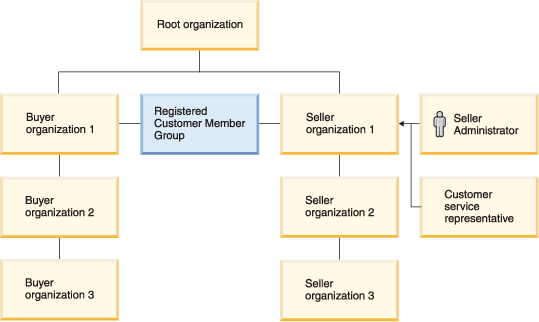
Authority to manage users
A Seller Administrator can manage users in organizations that belong to member groups owned by the administrator role organization. A Seller Administrator can also manage users in all organizations where they play their administrator role.
Consider the following example:

In the preceding diagram, the Seller Administrator can manage users in Buyer organization 1, Buyer organization 2, and Buyer organization 3. This administrator can manage these users through the Registered Customer member groups. The Seller Administrator can also manage users in Seller organization 1 (role organization) and Seller organization 2 (through role inheritance) and Seller organization 3 (through role inheritance). This administrator can manage these users because the administrator has a Seller Administrator role in those organizations.
The Seller Administrator can assign a user a role under organizations that are direct descendants of the Seller Administrators role organization (Seller organization 1).
Then, Seller Administrator can manage users in Buyer organization 1, Buyer Organization 2, Buyer organization 3, Seller organization 1, Seller organization 2, and Seller organization 3.
A Seller Administrator can assign roles under only Seller organization 1, Seller organization 2, and Seller organization 3 to users that belong to Buyer organization 1, Buyer organization 2, Buyer organization 3, Seller organization 1, Seller organization 2, and Seller organization 3.
If a Seller Administrator assigns roles to a CSR or a Customer Service Supervisor, two factors determine which users the CSR can manage:
-
The CSR can manage users through a Registered Customers member group
-
The CSR can assign a user a role under organizations that are direct descendants of the CSR role organization
In the preceding diagram, the CSR can manage users in Buyer organization 1, Buyer organization 2, and Buyer organization 3. The CSR can assign roles under Seller organization 1, Seller organization 2, and Seller organization 3 to users who belong to Buyer organization 1, Buyer organization 2, or Buyer organization 3.